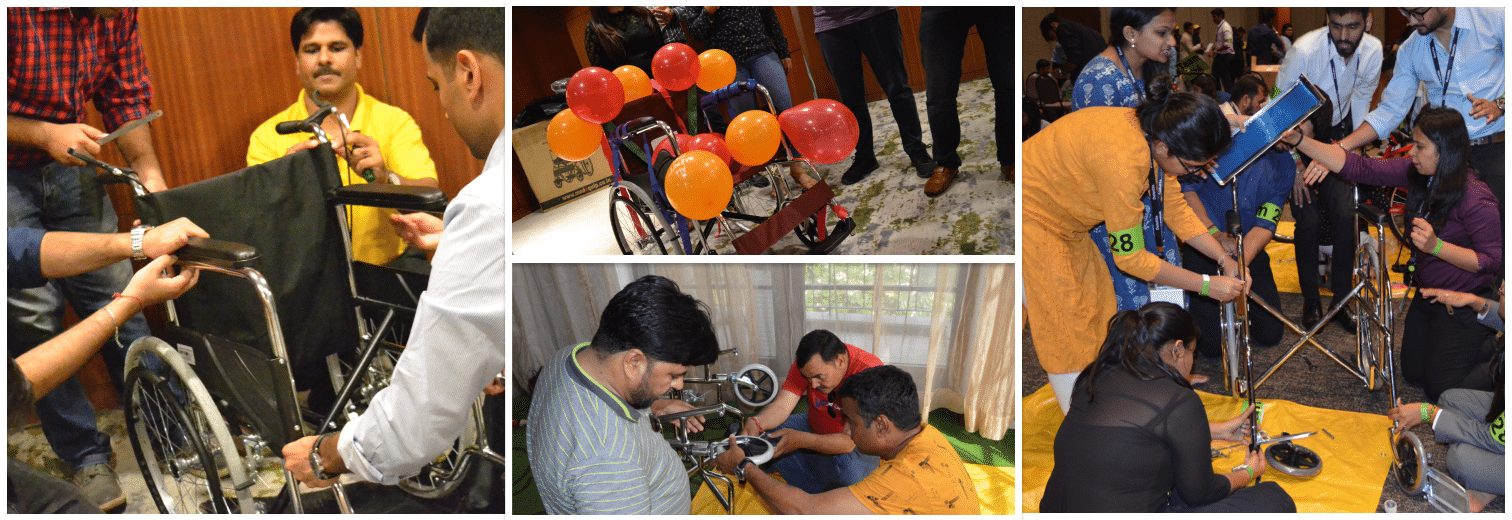The Tuckman model remains one of the most practical and intuitive frameworks for understanding team dynamics. Yet, it’s often mentioned only in passing during workshops or team-building sessions. At FocusU, we believe that when used meaningfully, this model can be a powerful lens for team leaders, facilitators, and HR professionals to assess and guide their teams through each stage of development.
The Origin of the Tuckman Model
Table of Contents
Developed by psychologist Dr. Bruce Tuckman in 1965, the model originally features four stages: Forming, Storming, Norming, and Performing. Later, in 1977, Tuckman added a fifth stage, Adjourning, to reflect the realities of team dissolution after task completion. While simple, each phase offers profound insights into team behavior, decision-making, and productivity.
Overview
| Forming | Storming | Norming | Performing | Adjourning |
| Infant | Puberty | Adolescence | Maturity | Reversion |
| At Communication Level | ||||
| Courteous, Hierarchical | Broken down, unstructured | Structured and reflective | Generative, productive, creating network | Purposeful, conclusive |
| At Relationship Level | ||||
| Polite, curious, wary, awkward and tense | Stressful, fiery, clique forming, disagreements | Stable roles, rules defined, reflective, WE before I | Seeks for development, trusting, openness, enabled | Bonded memories, maintains connection, anxiety, insecure |
| At Task Level | ||||
| Information gathering, adjustments | Define boundaries | Structured, organized, clear goals and targets | Task oriented, creative, PDCA, driven | Handing over, concluding |
| Leadership Style | ||||
| Directing (telling) | Coaching (advising) | Participative (facilitating and enabling) | Delegating (overseeing) | Directing (concluding) |
Why This Model Still Matters Today
In a post-pandemic world where hybrid work is the norm, the Tuckman model offers a human-centered approach to team development. We’ve seen its value not just in co-located teams but also in virtual and cross-functional teams. The model helps frame conversations around psychological safety, communication, accountability, and collaboration.
Let’s dive into each stage, integrating corporate learning insights and practical applications:
1. Forming: The Icebreaker Phase
Behavioral Traits: Politeness, excitement, anxiety, hesitancy.
Communication: Courteous and often hierarchical. Roles are unclear.
Leader’s Role: Directive. Establish clarity and psychological safety.
Forming is the initial stage for all team formation. Members are curious about each other; communication is generally superficial and courteous. It can be hierarchical especially for some new teams that were formed with a defined structure. Occasion awkwardness can be felt as the each member is adjusting to the new “team atmosphere”. If a leader has been appointed, the situation calls for a directive style in leading as the team is in a volatile stage, waiting for someone to shine the light.
In our workshops, we often notice that new teams tend to operate with a “wait and see” mindset. Everyone is cautious, scanning the environment, trying to understand how things work. At this point, team members need direction, role clarity, and structure. We recommend leaders facilitate icebreakers, set expectations clearly, and foster open communication.
L&D Application: This is a good stage to run onboarding or orientation sessions, values-alignment workshops, or even simple personality-mapping exercises like Emergenetics or DISC to help individuals learn about each other.
2. Storming: The Friction Phase
Behavioral Traits: Conflict, resistance, frustration, jockeying for roles.
Communication: Unstructured, emotionally charged.
Leader’s Role: Coaching. Help navigate conflicts without taking over.
Getting into disagreement is inevitable for teams. As part the growing stage, if the storm does not sink the ship, it will make the crew stronger. It is common that intra-group communication breaks down and it bears no structure too. Cliques started forming to establish pecking order, frequent disagreements result in tension filling the “team atmosphere”. Boundaries are taking shape but it is still very vague to the members. A leader under such situation should play as a coach, giving timely advices to the members, as such taking the team out of the storm gradually.
In our experience, this stage is where most teams either stall or begin to bond. It’s uncomfortable – but necessary. Differences in work style, communication preferences, or unclear responsibilities can lead to friction. However, if managed well, this tension fuels trust and collaboration.
We’ve noticed that team leaders who approach this stage with empathy and facilitation skills can transform conflict into clarity.
L&D Application: Run conflict resolution workshops, feedback training, or team chartering exercises. Also, coaching interventions can be powerful at this stage.
Related Reading: Leaders Eat Last: Building Trust and Empathy for High-Performing Teams
3. Norming: The Alignment Phase
Behavioral Traits: Cohesion, role clarity, shared goals.
Communication: More structured, feedback loops are in place.
Leader’s Role: Facilitative. Support autonomy, encourage initiative.
Out of the storm, come the still waters. Progressively, intra-group communication of the team takes on a clearer structure. Crucially team members are reflective of their behaviors that led or lagged the team’s performance. Roles and responsibilities are in place, stability is felt by all. Imperatives to the team, goals and targets are well defined and accepted by the members. A leader should facilitate and enable the members to act at this stage.
This stage often brings a collective sigh of relief. People have figured out how to work together. There’s trust, processes are in place, and focus starts shifting toward performance.
In our offsites and team alignment programs, we often help teams at this stage build long-term collaboration habits. Leaders need to avoid becoming complacent and instead encourage feedback, growth, and recognition.
L&D Application: Leadership development programs, peer learning circles, and internal mentorship can deepen bonds.
Related Reading: The Secret to Great Teams? Understanding Each Other
4. Performing: The Peak Performance Phase
Behavioral Traits: High productivity, collaboration, proactive problem-solving.
Communication: Open, trusting, solution-focused.
Leader’s Role: Delegation and empowerment.
Most wanted by all teams, is the stage of performing. A trusting attitude and openness enables them to resolve any conflicts without needing intervention from the leader. Not only is the team driven and task oriented, each member is also well equipped with the required functional skills to act and perform. Seeking for development opportunities from the leader is common in this stage. The leader takes a back seat by delegation of tasks to the members and things will get done.
Teams in this phase are like well-oiled machines. But getting here isn’t automatic. We’ve noticed that what sustains high-performing teams is a shared sense of purpose, regular recognition, and space for innovation.
It’s important for leaders to get out of the way while still providing support and celebrating wins.
L&D Application: Encourage thought leadership, cross-functional projects, and innovation sprints.
Related Reading: 4 Leadership Insights For A High Performance Team
5. Adjourning: The Transition Phase
Behavioral Traits: Pride, nostalgia, anxiety, closure.
Communication: Reflective, sometimes emotional.
Leader’s Role: Guide transition, recognize contributions.
This stage signifies each member’s departure from the team. Usually, the required tasks have been completed and the purpose has been achieved. Members can now move on to new tasks or another team. It is common to hand over the incomplete tasks to another team. However, the members will retain the memories of their successful journey. Adjourning also means changing and inadvertently, this would induce uncertainly and anxiety to some members. The exiting leader should exercise resolution and firmness when communicating the impending changes.
Often overlooked, this phase is critical in knowledge-based organizations where team structures are fluid. Whether it’s the end of a project, a product launch, or a restructuring, taking time to acknowledge contributions and celebrate success matters.
We’ve seen teams perform rituals – like storytelling circles, closing retrospectives, or even thank-you walls – to mark this phase meaningfully.
L&D Application: Closing reflections, storytelling exercises, and knowledge-sharing sessions ensure continuity and preserve institutional memory.
Putting the Tuckman Model Into Action
Many organizations admire the model but struggle to apply it practically. Here are a few tips from our fieldwork:
- Diagnose your team’s stage regularly. Teams are dynamic; external events or new members can reset the stage.
- Adjust your leadership style. Tuckman’s model mirrors situational leadership perfectly.
- Create a team charter. Align on shared values, roles, and norms early on.
- Facilitate regular feedback loops. This helps prevent regression to earlier stages.
One tool we often recommend is Don Clark’s free team effectiveness diagnostic. It’s a simple yet powerful way to identify where your team is and start important conversations.
Final Thoughts
Tuckman’s Team Development Model may be over five decades old, but it remains a timeless guide to understanding human dynamics within teams. In a world increasingly focused on agility and collaboration, the need to nurture teams through their developmental stages is more crucial than ever.
In our experience, teams that are consciously nurtured through these phases outperform those that are left to ‘figure it out’. As leaders, facilitators, and HR professionals, we owe it to our teams to be aware, intentional, and supportive throughout the journey.
Which stage do you think your team is in today? Take a moment to reflect – and help them move forward.





